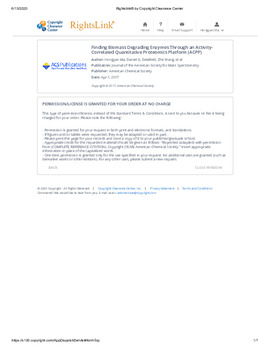| dc.description.abstract | The detection and identification of bioactive molecules (e.g. therapeutic small-molecule lead compounds, functional proteins) from complex mixtures is often a critical step in various biochemical and biomedical research fields. Conventional approaches typically rely on the purification of the molecules of interest that is guided by a specific activity/function followed by structure elucidation, chemical/physical property characterization, and bioactivity evaluation. The bioassay-guided purification/characterization process is often conducted in a labor-intensive and low-throughput manner consisting of repeated experimental steps. The lack of tools to directly pinpoint the bioactive molecules from complex crude biological samples is currently a painful challenge in the discovery of new bioactive molecules from biological samples. Emerging LC-MS-based metabolomic and proteomic approaches enabled rapid and high-throughput identification of the proteins and bioactive small molecules from complex biological samples (e.g. natural product extracts/fractions, cell lysates). Nevertheless, it remains challenging to incorporate both the activity and chemical identifications of the bioactive molecules directly from the complex mixtures. To address this problem, we have developed two new approaches: 1) Lickety-split Ligand Affinity based Molecular Angling System (LLAMAS), and 2) Activity-Correlated Quantitative Protein Profiling Platform (ACPP), for direct detection and identification of bioactive small molecules and proteins, respectively, from complex biological samples by combining the activity-based assays with quantitative metabolomics and proteomics studies.
In natural product discovery, bioactive compounds are usually purified via bioassay-guided fractionations. Loss of the activity or failure in the purification of the minor or unstable bioactive compounds during the commonly multi-step workflows (e.g. multiple rounds of biological tests and chemical fractionations) is a common and costly limitation in the isolation of bioactive natural products. A major reason behind the problem lies in that most common bioassay models (e.g. phenotypic and genotypic) are not accessible to the direct detection and identification of individual bioactive chemical components from complex fractions and crude extracts rich in di-verse secondary metabolites. To address this, the Lickety-split Ligand Affinity based Molecular Angling System (LLAMAS), an ultrafiltration-LC-PDA-MS/MS-based DNA binding assay, coupled with modern dereplication tools (e.g. GNPS, and DNP), was established for quick and easy identification and dereplication of DNA binding agents in complex samples. This assay was developed using eight known small-molecule DNA binders (1-8) with different properties (e.g. DNA binding mechanism, solubility, and LC-MS performance). It was further validated by the successful detection of two DNA binders that were spiked into a highly complex soil extract and the dereplication of three known DNA intercalators including actinomycin D (9), V (10) and X0β (11) from the crude extract of Streptomyces antibioticus. To improve the throughput, the approach was further optimized to a 96-well plate-based assay—LLAMAS 2.0. Seven DNA binding candidates, including berberine (12), palmatine (13), coptisine (14), fangchinoline (15), tetrandrine (16), daurisoline (17), and dauricine (18) were detected and identified from three herbal extracts through high-throughput screening of 394 plant extracts. The results demonstrated that LLAMAS enables efficient identification and dereplication of DNA binding molecules directly from complex metabolite extracts in the early stage of natural product discovery pipelines to avoid repeated purification of known active compounds.
Functional protein (e.g. catalytic enzymes) identification and its activity validation is often a time-consuming and labor-intensive process due to the inclusion of protein overexpression and purification steps. Proteomics approaches have been applied for the discovery of novel enzyme candidates from microbial secretomes by comparing protein expression profiles with the enzyme activity of different secretome cocktails obtained under different growth conditions. However, the activity measurement of each enzyme candidate is needed for confident enzymatic activity assignment, which remains to be elucidated. To address this challenge, an Activity-Correlated Protein Profiling Platform (ACPP) was developed, that can systematically correlates protein-level enzymatic activity patterns with protein elution profiles obtained from the “native” LC prefractionation and quantitative proteomics analysis. Enzymatic activity patterns in sequential fractions measured in different micro-scale bioassays were correlated with protein elution pro-files (protein relative intensities in each fraction) using the Pearson Correlation algorithm to generate R-scores. The activity was then confidently assigned based on R-score and record of predicted functions in free-accessible databases, such as NCBI and UniProt. The ACPP has been successfully applied to the identification of two types of active biomass-degrading enzymes (e.g. starch hydrolysis enzymes and cellulose hydrolysis enzymes) from Aspergillus niger secretome in a multiplexed fashion. By determining protein elution profiles of 156 proteins in A. niger secretome, we confidently identified the 1,4-α-glucosidase as the major active starch hydrolysis enzyme (R = 0.96) and the endoglucanase as the major active cellulose hydrolysis enzyme (R = 0.97). The results demonstrated that the ACPP facilitated the discovery of bioactive enzymes from complex protein samples in a high-throughput, multiplexing, and untargeted fashion. | en_US |

